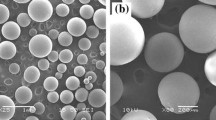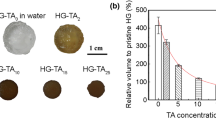Abstract
To fabricate a controlled release system for icariin for application to tissue engineering, gelatin/hyaluronic acid (Gel/HA) composite microspheres loaded icariin were prepared through emulsion-coagulation method using glutaraldehyde (GA) as cross-linker. The free Gel/HA and Gel/HA-icariin microspheres were characterized by Fourier transforms infrared (FTIR) and scanning electron microscopy (SEM). The influences of cross-linker content on the drug loaded and encapsulation efficiency of the Gel/HA microspheres were investigated, and the effects of cross-linker content, cross-linking time and loaded drug content on the release behavior of icariin in vitro were also studied. Moreover, the in vitro release kinetics of icariin from Gel/HA microspheres was analyzed. The results showed that both Gel/HA and Gel/HA-icariin microspheres are spherical with size ranged from 20 to 60 μm, and the Gel/HA-icariin microspheres showed rougher surface than Gel/HA microspheres. The loaded efficiency and the encapsulation efficiency decreased with increasing cross-linker content. The cumulative release of icariin from the Gel/HA microspheres decreased with increasing GA content and cross-linking time; however, the cumulative release increased with increasing icariin content in the microspheres. The results of icariin release kinetics from Gel/HA microspheres indicated Fickian diffusion. We concluded that it was feasible for Gel/HA to act as carriers of slow release of microspheres, and the release rate of icariin from the microspheres was adjustable.







Similar content being viewed by others
References
Hardingham T, Tew S, Murdoch A (2002) Tissue engineering: chondrocytes and cartilage. Arthritis Res 4:S63–S68
Saraf A, Mikos AG (2006) Gene delivery strategies for cartilage tissue engineering. Adv Drug Deliv Rev 58:92–603
Lee JY, Seol YJ, Kim KM, Lee YM, Park YJ, Rhyu IC, Chung CP, Lee SJ (2004) Transforming growth factor (TGF)-beta1 releasing tricalcium phosphate/chitosan microgranules as bone substitutes. Pharm Res 21:1790–1796
Bi L, Cheng W, Fan H, Pei G (2010) Reconstruction of goat tibial defects using an injectable tricalcium phosphate/chitosan in combination with autologous platelet-rich plasma. Biomaterials 31:3201–3211
Okada M, Sangadala S, Liu Y, Yoshida M, Reddy BV, Titus L, Boden SD (2009) Development and optimization of a cell-based assay for the selection of synthetic compounds that potentiate bone morpho-genetic protein-2 activity. Cell Biochem Funct 27:526–534
Basmanav FB, Kose GT, Hasirci V (2008) Sequential growth factor delivery from complexed microspheres for bone tissue engineering. Biomaterials 29:4195–4204
Zhao J, Ohba S, Shinkai M, Chung UI, Nagamune T (2008) Icariin induces osteogenic differentiation in vitro in a BMP- and Runx2-dependent manner. Biochem Biophys Res Commun 369:444–448
Hsieh TP, Sheu SY, Sun JS, Chen MH, Liu MH (2010) Icariin isolated from Epimedium pubescens regulates osteoblasts anabolism through BMP-2, SMAD4, and Cbfa1 expression. Phytomedicine 17:414–423
Zhao J, Ohba S, Komiyama Y, Shinkai M, Chung UI, Nagamune T (2010) Icariin: a potential osteoinductive compound for bone tissue engineering. Tissue Eng Part A 16:233–243
Zhang X, Guo Y, Li DX, Wang R, Fan HS, Xiao YM (2011) The effect of loading icariin on biocompatibility and bioactivity of porous beta-TCP ceramic. J Mater Sci Mater Med 22:371–379
Peng ZY, Li ZP, Shen YQ (2012) Preparation and in vitro characterization of gelatin microspheres containing 5-fluorouracil. J Macromol Sci B 51:1117–1124
Xiong LZ, He ZQ (2012) Influences of process variables on size of chitosan microspheres. J Macromol Sci B 51:2333–2340
Peng ZY, Shen YQ, Li ZP (2012) Control of size and morphology of gelatin microspheres. J Macromol Sci B 51:12–21
Unterman SA, Gibson M, Lee JH, Crist J, Chansakul T, Yang EC, Elisseeff JH (2012) Hyaluronic acid-binding scaffold for articular cartilage repair. Tissue Eng Part A 18:2497–2506
Collins MN, Birkinshaw C (2013) Hyaluronic acid based scaffolds for tissue engineering-a review. Carbohydr Polym 92:1262–1279
Segura T, Anderson BC, Chung PH, Webber RE, Shull KR, Shea LD (2005) Crosslinked hyaluronic acid hydrogels: a strategy to functionalize and pattern. Biomaterials 26:359–371
Collins MN, Birkinshaw C (2007) Comparison of the effectiveness of four different crosslinking agents with hyaluronic acid hydrogel films for tissue-culture applications. J Appl Polym Sci 104:3183–3191
Zhou ZH, Chen JH, Peng C, Huang TL, Zhou H, Ou BL, Chen J, Liu QQ, He SL, Cao DF, Huang HH, Xiang LJ (2014) Fabrication and physical properties of gelatin/sodium alginate/hyaluronic acid composite wound dressing hydrogel. J Macromol Sci A 51:318–325
Peng ZY, Li ZP, Shen YQ (2012) Influence of chemical cross-linking on properties of gelatin/chitosan microspheres. Polym Plast Technol 51:381–385
Peng ZY, Li ZP, Shen YQ, Zhang F, Peng XC (2012) Fabrication of gelatin/chitosan microspheres with different morphologies and study on biological properties. Polym Plast Technol 51:739–743
Zhou ZH, He SL, Huang TL, Liu LH, Liu QQ, Zhao YM, Ou BL, Zeng WN, Yang ZM, Cao DF (2013) Degradation behavior and biological properties of gelatin/hyaluronic acid composite scaffolds. Mater Res Innov 17:420–424
Zhou ZH, Yang ZM, Huang TL, Liu LH, Liu QQ, Zhao YM, Zeng WN, Yi QF, Cao DF (2013) Effect of chemical cross-linking on properties of gelatin/hyaluronic acid composite hydrogels. Polym Plast Technol 52:45–50
Zhou ZH, Yang ZM, Huang TL, Liu LH, Liu QQ, Zeng WN, Cao DF, Ma SJ (2012) Characterization of biocompatible scaffolds based on gelatin and hyaluronic acid for fibroblasts culture. Polym Polym Compos 20:791–795
Zhou ZH, He SL, Huang TL, Peng C, Zhou H, Liu QQ, Zeng WN, Liu LH, Huang HH, Xiang LJ, Yan H (2015) Preparation of gelatin/hyaluronic acid microspheres with different morphologies for drug delivery. Polym Bull 72:713–723
Peppas NA (1985) Analysis of Fickian and non-Fickian drug release from polymers. Pharm Acta Helv 60:110–111
Acknowledgments
This work was financially supported by the National Natural Science Fund of China (Nos. 51273062, 51443002), IUC Program of Hunan Provincial Education Department (No. 15CY004) and the Aid Program for Science and Technology Innovative Research Team in Higher Educational Institutions of Hunan Province.
Author information
Authors and Affiliations
Corresponding author
Rights and permissions
About this article
Cite this article
Yan, H., Zhou, Z., Huang, T. et al. Controlled release in vitro of icariin from gelatin/hyaluronic acid composite microspheres. Polym. Bull. 73, 1055–1066 (2016). https://doi.org/10.1007/s00289-015-1534-x
Received:
Revised:
Accepted:
Published:
Issue Date:
DOI: https://doi.org/10.1007/s00289-015-1534-x




